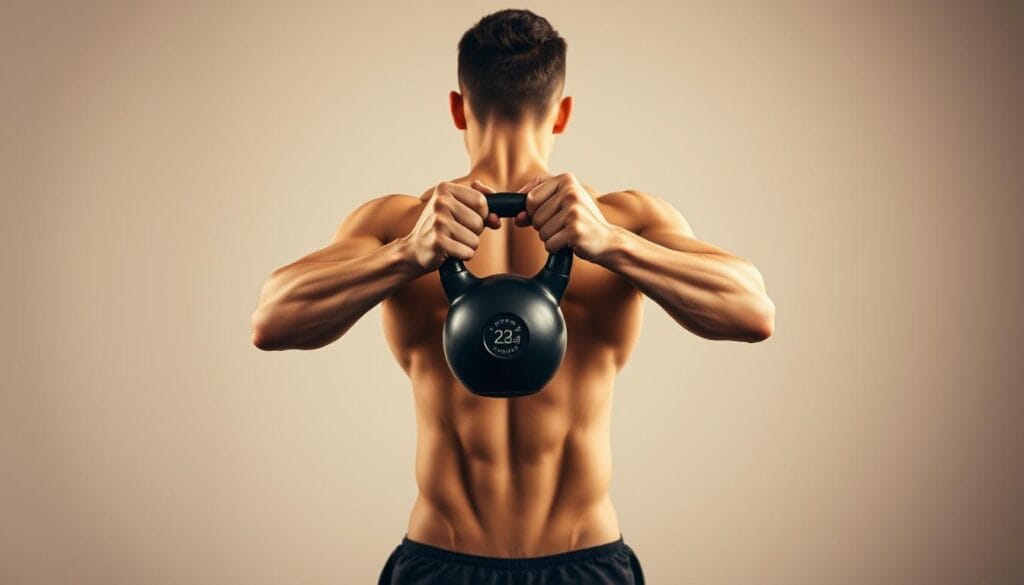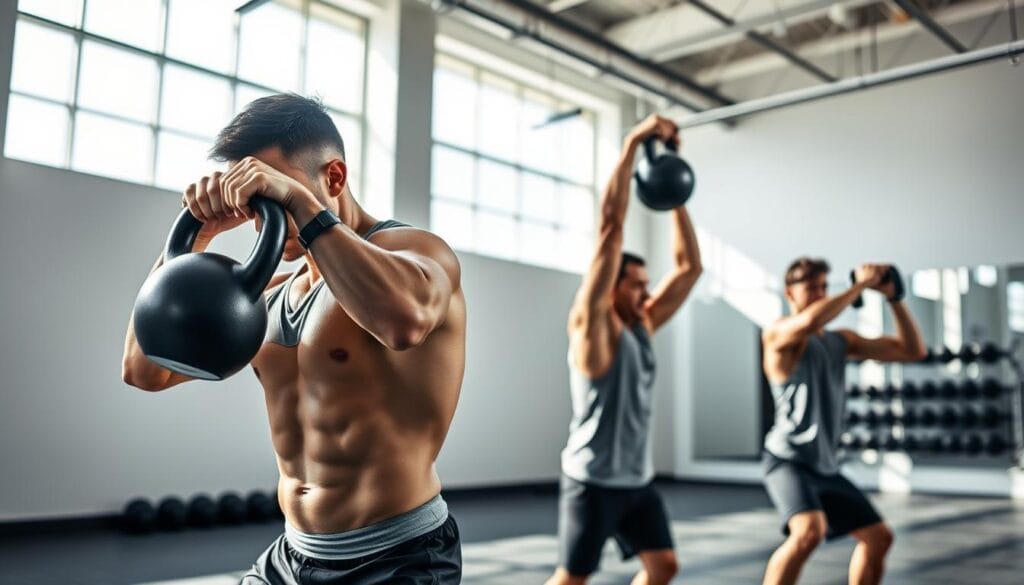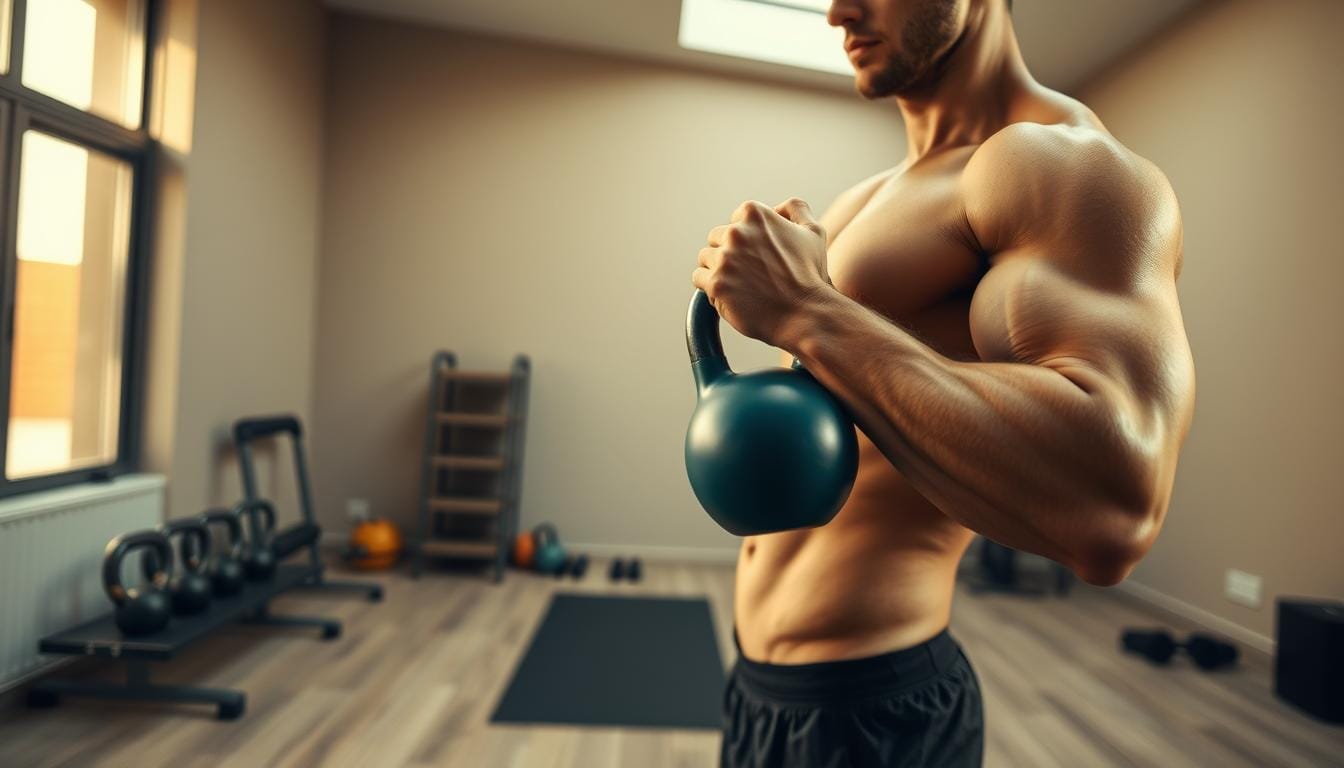Beginner-Friendly Kettlebell Workout Chest Routine for Home
I remember the day I found kettlebell training. It changed my fitness journey. My arms were weak, and my core felt disconnected. Traditional weightlifting seemed too hard.
Kettlebell training is a great way to start, especially for beginners. With a 15-pound kettlebell, you can do a full chest workout. It works many muscles at once.
Kettlebell workouts are different from gym equipment. They use dynamic movements to build strength, power, and endurance. Your chest muscles will get stronger and more functional.
This routine is perfect for home workouts. It’s great for beginners or those looking for a change. You’ll build muscle, burn calories, and improve your conditioning.
Get ready to transform your body in your living room. This workout will challenge you and change your fitness journey.
Table of Contents
Understanding the Benefits of Kettlebell Training for Chest Development
Kettlebell training is a unique way to build your chest muscles. It’s different from regular weight training. These tools help you get stronger and fitter in many ways.
Kettlebell exercises work many muscles at once. This makes them great for building chest strength. The double kettlebell press and kettlebell floor press are especially good for this.
Building Functional Strength with Kettlebells
Functional strength is about being strong in real-life situations. Kettlebell training helps you get stronger in a way that’s useful every day. Kettlebells are special because they:
- Make muscles work harder
- Help your core stay stable
- Let you move more freely
- Improve how muscles work together
Advantages of Compound Movements
Compound movements with kettlebells are very effective. They work many muscles at once. For example, the double kettlebell press works your chest, shoulders, triceps, and core all at once.
Cardiovascular Benefits During Strength Training
Kettlebell workouts are great for both strength and heart health. Studies show they can improve:
- Aerobic power
- Heart health
- How well your body handles sugar
- Your overall metabolic health
“Kettlebell training is not just about lifting weights; it’s about transforming your entire approach to fitness.” – Fitness Expert
For the best results, start with lighter weights and focus on doing the exercises right. The American Council on Exercise suggests:
- Males: Start with 15-25 lbs
- Females: Begin with 8-15 lbs
- Do 2-3 workouts a week
- Do 6-8 reps for each exercise
Essential Equipment and Safety Guidelines for Your Kettlebell Chest Workout
Starting your kettlebell chest workout needs careful planning. You must know the right equipment and safety rules. Choosing the right kettlebell and following safety tips will make your workout better and safer.
When starting your single-arm kettlebell push press, keep these key equipment tips in mind:
- Beginner kettlebell weight for women: 8-15 pounds
- Beginner kettlebell weight for men: 15-25 pounds
- Recommended initial training frequency: 2-3 times per week
Always put safety first. Before starting your kettlebell chest workout, follow these important guidelines:
- Do a 5-10 minute dynamic warm-up to get your muscles ready
- Keep the right form during each exercise
- Slowly increase the weight as you get stronger
“Technique trumps weight every time in kettlebell training.” – Fitness Experts
The single-arm kettlebell push press needs focus on body mechanics. Start with lighter weights to learn the movement before adding more weight. Studies show that proper warm-ups can cut injury risks by about 30%.
| Training Aspect | Beginner Recommendation |
|---|---|
| Initial Kettlebell Weight | 8-25 pounds depending on gender |
| Repetitions per Exercise | 12-15 reps |
| Weekly Training Frequency | 2-3 sessions |
Remember: Your safety and proper technique are key to a lasting kettlebell chest workout routine.
Proper Form and Technique Fundamentals
Mastering kettlebell exercises needs focus and detail. Success with kettlebell push-up and other chest exercises depends on core techniques. These techniques ensure safety and effectiveness.
Proper form is key to avoid injuries and get the best results. Athletes who focus on technique see better strength gains. They also have less risk of muscle strain.
Breathing Patterns During Exercises
Good breathing makes a big difference in kettlebell push-up performance. Here are some breathing tips:
- Inhale during the lowering phase of movements
- Exhale forcefully during the lifting phase
- Keep a steady breath rhythm to stabilize your core
- Practice deep, diaphragmatic breathing
Core Engagement Tips
Your core is a key stabilizer in kettlebell exercises. Use these core engagement tips:
- Brace your abdominal muscles before starting each movement
- Keep your spine in a neutral position
- Make sure your midsection is tense
- Imagine pulling your belly button toward your spine
Common Form Mistakes to Avoid
It’s important to avoid common mistakes for safe and effective kettlebell training. Here are some common errors:
| Mistake | Correction |
|---|---|
| Rounded Back | Maintain straight spine alignment |
| Loose Grip | Firm, controlled kettlebell grip |
| Incorrect Breathing | Synchronize breath with movement |
“Technique trumps weight every time in kettlebell training.” – Fitness Experts
Remember, perfecting your form takes practice. Start with lighter weights and gradually increase intensity as your technique improves.
Kettlebell Workout Chest: Foundation Exercises for Beginners

Starting your kettlebell workout chest journey is exciting. You’ll learn key exercises that build strength and muscle. Beginners can transform their chest training by mastering these essential movements.
Your first kettlebell chest workout should focus on building core strength and chest muscles. The kettlebell chest fly and other strategic movements will help you build a solid foundation for advanced training.
“Proper technique matters more than weight when learning kettlebell chest exercises”
Key Beginner Exercises
- Kettlebell Floor Press
- Single-Arm Kettlebell Chest Fly
- Kettlebell Bench Press
- Incline Kettlebell Press
- Kettlebell Push-Up Variations
When choosing your kettlebell, beginners should start with a weight between 10-15 pounds. This range allows proper form development without risking injury.
| Exercise | Muscle Groups | Recommended Reps |
|---|---|---|
| Kettlebell Floor Press | Chest, Triceps | 8-12 reps |
| Kettlebell Chest Fly | Chest, Shoulders | 10-15 reps |
| Incline Kettlebell Press | Upper Chest, Shoulders | 8-10 reps |
Remember to maintain proper form during your kettlebell workout chest routine. Focus on controlled movements, engaging your core, and breathing consistently. This will help you maximize muscle development and prevent injuries.
Mastering the Kettlebell Floor Press for Chest Development
The kettlebell floor press is a unique way to strengthen your chest. It targets specific muscles and is easy on your joints. This makes it great for athletes and fitness lovers at any level.
Setup and Execution Guide
Getting the kettlebell floor press right is key. Lie on the floor with your knees bent and feet flat. Place the kettlebell beside your shoulder, then press it up. Important tips include:
- Maintain a 45-degree angle between your elbow and torso
- Keep your core engaged throughout the movement
- Control the weight during both concentric and eccentric phases
Progressive Overload Strategies
To get the most out of the kettlebell floor press, use smart progression. Here are some training volumes to follow:
| Training Stage | Sets | Repetitions | Weight Approach |
|---|---|---|---|
| Primary Exercise | 3 | 8-10 | Heavier weights |
| Secondary Exercise | 3 | 10-12 | Lighter weights |
Variations for Different Fitness Levels
The kettlebell floor press can be adjusted for everyone. Beginners start with lighter weights and focus on form. Advanced users can try harder variations. Always listen to your body and progress gradually.
“The floor press reduces range of motion compared to standard bench press, allowing for focused strength development in the lockout position.” – Strength Training Experts
Adding the kettlebell floor press to your chest workout boosts strength and stability. It also reduces shoulder strain. Always keep proper form and challenge yourself to get the best results.
Advanced Kettlebell Chest Exercises and Variations
As you get better at kettlebell training, you can try more challenging chest exercises. The double kettlebell press is a great example. It works many muscles at once.
“Advanced kettlebell exercises transform your chest workout from basic to extraordinary.” – Fitness Experts
Kettlebell workouts are great for your chest. They work more stabilizing muscles than dumbbells do. This means you build strength in a more complete way.
- Kettlebell Seesaw Press: Alternating arm movements for balanced chest development
- Single-Arm Floor Press: Enhances muscle symmetry and core engagement
- Kettlebell Crush Grip Push-Up: Intensifies inner chest muscle activation
- Decline Kettlebell Press: Targets lower pectoral muscles with increased effectiveness
Many kettlebell exercises are done with one arm. This makes them very challenging. Using one kettlebell can cut muscle imbalances by half. This leads to more even strength.
| Exercise | Muscle Engagement | Difficulty Level |
|---|---|---|
| Double Kettlebell Press | Chest, Shoulders, Triceps | Advanced |
| Kettlebell Windmill | Chest, Core, Obliques | Intermediate to Advanced |
| Kettlebell Floor Press | Chest, Triceps, Stabilizers | Intermediate |
Pro Tip: Always keep proper form when doing these exercises. Start with lighter weights and add more as you get better. This helps avoid injuries and builds muscle well.
Creating Your Progressive Workout Schedule
Creating a good kettlebell workout for your chest needs careful planning. You must know your body’s limits. Your training plan will guide you to stronger chest muscles.
Weekly Training Structure
A good kettlebell chest program has a clear plan. Your weekly routine should include:
- 3 dedicated strength training sessions
- Focused chest and upper body exercises
- Balanced workout intensity
Rest and Recovery Guidelines
Rest is key in any kettlebell chest workout. Experts suggest:
- Give yourself 48-72 hours off between hard chest workouts
- Pay attention to how your body feels
- Use active recovery methods
Progress Tracking Methods
Keeping track of your progress helps you get better at kettlebell chest workouts. Try these methods:
| Tracking Method | Frequency | Purpose |
|---|---|---|
| Weight Progression | Every 2 weeks | Measure strength gains |
| Repetition Increase | Weekly | Monitor endurance |
| Body Measurements | Monthly | Assess muscle development |
“Consistency and patience are the keys to unlocking your kettlebell chest workout potential.”
Remember, your kettlebell workout chest journey is unique. Adapt these guidelines to your personal fitness level and goals.
Combining Kettlebell Movements for Maximum Chest Engagement
Kettlebell training is a great way to work your chest muscles. By mixing different kettlebell exercises, you can make your workouts more effective. This approach boosts muscle engagement and fitness.

Trainers suggest combining various movements for a full chest workout. A good mix includes:
- Single-arm kettlebell push press
- Kettlebell floor press
- Kettlebell chest-loaded swing
“Variety is the key to continuous muscle adaptation and growth” – Fitness Performance Experts
The single-arm kettlebell push press is a powerful exercise. It works your chest, shoulders, and core at the same time. Adding this to your routine challenges your muscles in a good way.
Kettlebell workouts are efficient, engaging about 80% of your muscles in 20 minutes. This makes kettlebell training great for building a strong chest.
| Exercise Combination | Muscle Groups Targeted | Recommended Sets |
|---|---|---|
| Push Press + Floor Press | Chest, Shoulders, Triceps | 3-4 sets |
| Chest Swing + Push Press | Full Upper Body | 3-4 sets |
Success comes from knowing how to put these exercises together right. Start with lighter weights and focus on form. Then, you can increase the weight as you get stronger.
Pro Tip: Always keep your core tight during kettlebell exercises. This helps work more muscles and keeps you safe from injury.
Conclusion
Starting your kettlebell workout chest journey is a great step towards getting stronger and fitter. These exercises are powerful and can improve your chest with just a few pieces of equipment. The most important thing is to keep practicing, focus on doing the exercises right, and slowly get better.
Kettlebell training is really effective. In just 12 minutes, you can get your heart rate up to 87% of its max. A short 5 to 7-minute workout can be as good as long cardio sessions. This shows that kettlebell workouts do more than just build muscle; they improve your overall fitness.
Success in kettlebell workouts depends on choosing the right weight and doing the exercises correctly. Start with 35 pounds for men and 18 pounds for women to build strength safely. By trying different exercises and staying disciplined, you’ll get a stronger, more defined chest and better overall fitness.
Be patient and excited as you start your kettlebell workout chest journey. Your dedication to learning, practicing, and pushing yourself will lead to amazing physical changes and new athletic abilities.







